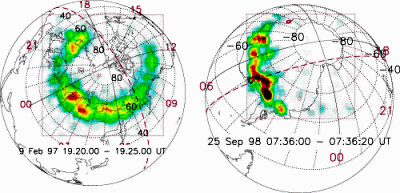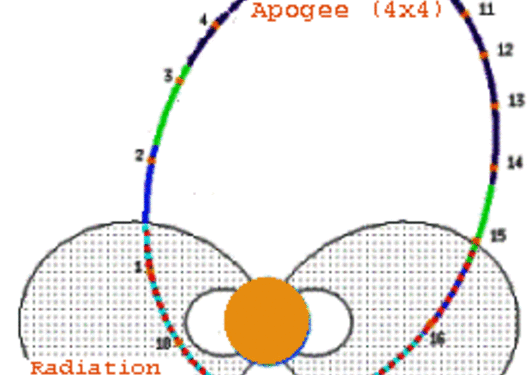PIXIE
PIXIE is an auroral imager operating on x-ray wavelengths corresponding to energies between 2 and 60 keV. It will monitor the spatial and temporal distribution of precipitating high energy electrons from space into the upper atmosphere. Observations can be made on the day side as well as on the night side of the Earth, and the measurements can provide height profiles of the ionization, electron density and conductivity at each point of the image.
Main content
These are global x-ray images of the Earth's aurora over the North Pole (left) and the South Pole (right), on 9 February 1997 and 25 September 1998, respectively. The pictures were taken by the PIXIE Imager aboard the NASA/POLAR satellite, and are presented in false colour with the colour corresponding to the measured x-ray intensity from blue (weakest) through red (strongest).
The x-ray energy range covered by these images is from about 2 keV to over 10 keV. When energetic electrons from the Earth's magnetosphere struck the upper atmosphere these x-rays were emitted. The intensity of the x-rays is directly related to the intensity of the precipitated electron flux.
The images illustrate one of the advantages of x-ray imaging of the aurora: insensitivity to sunshine. The day/night terminator is indicated by a dashed red line. In the left picture, Norway and Siberia are in darkness and Alaska and Canada are in the sunlight. The most intense auroral x-ray emission region is in the local time zone just after midnight in the north. The picture of the southern aurora shows the most intense x-ray emissions on the morning side.
The image over the North Pole was made with a five minute exposure time, whereas the image over the South Pole had an exposure time of only 20 seconds. The orbit of the Polar spacecraft was at this time when the pictures were taken, 8 Earth radii (~50 000 km) above the North Pole at the most, and just 0.8 Earth radii (~5000 km) above the South Pole. To learn more about PIXIE see: PIXIE's home page

